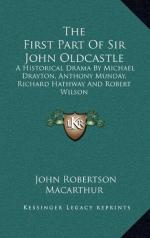|
This section contains 379 words (approx. 2 pages at 300 words per page) |
Encyclopedia of World Biography on Michael Drayton
The English poet Michael Drayton (1563-1631) attempted to create a strong national culture by turning for inspiration to English history rather than to foreign sources.
Like his contemporary William Shakespeare, Michael Drayton was the son of a prosperous Warwickshire tradesman. He received a good education as a page in the house of Sir Henry Goodere, but there is no record of his ever having studied at a university.
Drayton's first publication, The Harmony of the Church, a somewhat clumsy paraphrase of the Bible, appeared in 1591, when he was 28. Succeeding publications exemplify a wide variety of genres. Idea, the Shepherd's Garland (1593) is a collection of nine pastoral poems, celebrating ideal beauty, in imitation of Edmund Spenser. Idea's Mirror (1594), a sonnet sequence, also portrays the poet's beloved (probably Anne Goodere, the daughter of his patron), under the Platonic name of "Idea."
By 1593 Drayton had also written his first historical romance in verse, Piers Gaveston. Two heroic poems followed, drawing on incidents in English history: Robert, Duke of Normandy and Mortimeriados, both published in 1596. The latter, which portrays the evils of civil strife, was considerably revised and republished as The Baron's Wars (1603). The most popular of Drayton's early works, England's Heroical Epistles, was published in 1597. Written in imitation of Ovid's Heroides, it consists of a series of verse letters between lovers famous in English history.
Drayton turned to the fashionable genre of satirical verse in two rather obscure works, The Owl (1604) and The Man in the Moon (1606). Some of his most famous shorter works were published in Poems Lyric and Pastoral (1606), including the patriotic "Battle of Agincourt" and the "Ode to the Virginian Voyage," which celebrates English discoveries in America. Drayton's ambitious Polyolbion (1612-1622), a long topographical poem, describes region by region the beauties and traditions of England and attempts to provide a legendary basis for the Stuart claim to the English throne. The most important of the poems of Drayton's later years, his Nymphidia (1627), is a delicate mock-heroic tale of the fairy kingdom, peopled with characters like those that appear in Shakespeare's Midsummer Night's Dream.
Although Drayton often lacks dramatic power and intellectual depth, he has been rightly praised for his versatility, narrative skill, and insight into character. He died in London in 1631 and was buried in Westminster Abbey.
|
This section contains 379 words (approx. 2 pages at 300 words per page) |


